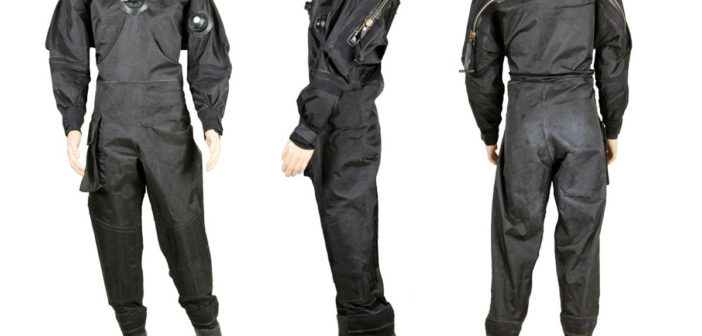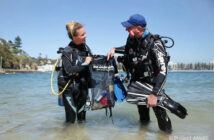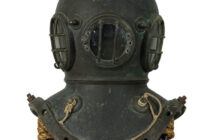For cold water divers, a drysuit is the best way to stave off the effects of exposure, especially if you’re on longer bottom times or if like us in BC, the best diving season corresponds with the colder parts of the year. A good drysuit is an investment though, and not something you should jump into casually. The type of diving you do, and the amount you’re able to invest, are the best ways to initially determine which type of drysuit may be best for you. By type, I talking about the material they’re made from. Cosmetic differences, like zipper placement, colour, and design, aren’t much of a factor here. Suit material, wrist and neck seals, and valve placements are though. So in this post, I’m going to look at the three main materials that drysuits are made of, neoprene, trilaminate/laminate, and vulcanized rubber, and talk about the pros and cons of each in my experience.
Neoprene
Neoprene suits come in several different types, and are suitable for almost all recreational, commercial, and scientific diving. Compressed, crushed, and regular neoprene are the base materials for these suits, and they’re held together at the seems by neoprene cement and stitching. Neoprene suits are very warm, and positively buoyant. Boots on these suits are more often attached than not, and they can have neoprene or latex neck and wrist seals. When they flood, these drysuits become really bad wetsuits.
Pros:
- durable; neoprene suits are tough, and have good lifespans with reasonable maintenance
- easy to fix; neoprene cement and basic knowledge of sewing can fix most problems, aquaseal works well too in a pinch
- warm; thinner undergarments needed because of neoprene’s thermal properties (I wear regular long underwear and wool socks in my 5mm drysuit in 4°C water)
- forgiving; neoprene stretches, so some weight gain (it happens!) isn’t as much of a problem
Cons
- bulky; even the best neoprene suit is still bulkier than ones made from trilaminate or even vulcanized rubber, they aren’t a great choice for a travelling recreational diver
- material issue; not suitable for potable water or contaminated environment dives
- heat stress risk; neoprene is a great insulator, and wearing too many insulating layers on a hard dive, or a long surface swim in the sun can increase the chance of a heat stress injury, so dress accordingly and pace yourself
Trilaminate or Laminated
Trilaminate and laminated suits are very popular with a number of divers, particularly because they are lightweight and easily transported compared to vulcanized rubber or neoprene drysuits. Trilaminate drysuits are suitable for recreational and most scientific diving, but aren’t well suited to commercial use. These suits are made by laminating two to three layers of durable material (such as fabric and butyl rubber), and are quite thin and by themselves, not very buoyant. Because they are so thin, they require “puff suits” or similar layered clothing for insulation, and often need boots (such as “rock boots”) as they end in a sock as opposed to a boot. Trilaminate and laminate suits are often fitted with latex neck and wrist seals.
Pros:
- lightweight; these suits weigh very little and are easy to transport, making them popular with travelling divers
- cost; laminated drysuits are frequently less expensive than neoprene or vulcanized rubber drysuits
- ease of movement; these suits are more flexible and easier to move in than either neoprene or vulcanized rubber suits
- some stretch; these suits are a bit forgiving on weight change, but not as much as neoprene is
Cons:
- lots of extras; boots, “puff suits” of drysuit long underwear
- difficult to repair; there are patch kits, but they’re of mixed quality and need time to set up properly
- exposure issue; unlike neoprene drysuits that will act like really bad wetsuits when flooded, laminated suits offer little insulating value, leading to a potential hypothermia issue
- material issue; most of these suits are unsuitable for potable water or contaminated environment dives, additionally, these suits are more fragile than either of the others
Vulcanized Rubber
These are heavy duty suits that trace their lineage back to the first suits used by divers. Made from heavy nylon material and vulcanized rubber in a process similar to the one used to make laminated suits, these suits are the choice for commercial and some scientific divers. Somewhat specialized, these suits are not often seen on recreational divers. These suits can have a rubber hood attached or not, and use latex wrist (and neck if there is no hood) seals. As with trilaminate suits, they need a “puff suit” of drysuit long underwear to provide insulation. Vulcanized rubber drysuits may have their boots attached or need a separate set of boots.
Pros:
- hazmat diving; these suits (in conjunction with full face masks or positive pressure diving hats) allow for diving in some pretty heinous “water”, making them the choice for many working divers
- easy to sanitize; the rubber these suits are made from is easily cleaned, making them a good for diving in sensitive areas
- easy to fix; for small punctures, duct tape can be used as an expedient repair material (I have seen this!)
- tough; these suits are made to last with reasonable maintenance
Cons:
- hard to fix; serious tears or large punctures need to be repaired at a proper facility to maintain the suit’s integrity
- bulky; not as bad as the neoprene, but still worse than the trilaminate and laminate suits, these aren’t great for travelling divers
- extras; sometimes boots, “puff suits” of drysuit long underwear
- exposure issue; unlike neoprene drysuits that will act like really bad wetsuits when flooded, laminated suits offer little insulating value, leading to a potential hypothermia issue
- no stretch; these suits are the size they are forever, so you need to match those sizes or be smaller
In my experience and observations, for general use, neoprene has been the best choice for most divers. It’s durable, easy to fix, and can sit middle of the row for cost, plus it’s warmer than the others. For purely recreational divers, trilaminate or laminate suits can be the better choice, as they tend to be less costly, and for the travelling cold water diver (especially on aircraft), they fit better in luggage. Vulcanized rubber suits, to me, are highly specialized suits, best left to public safety, scientific, and commercial divers. Ultimately, the decision is up to the individual diver, but I hope this helps.









